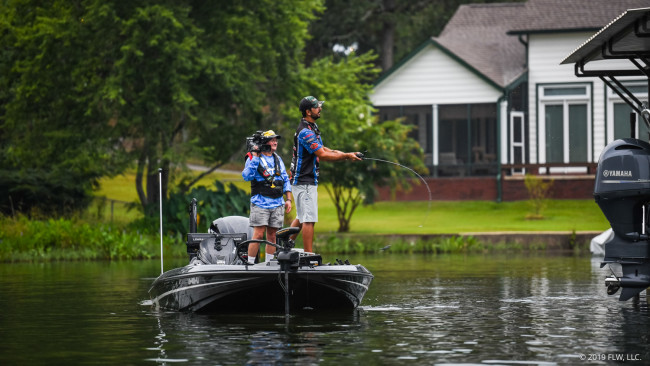Make the Most of Whopper Ploppers
How to catch bass on a Plopper like Nick LeBrun
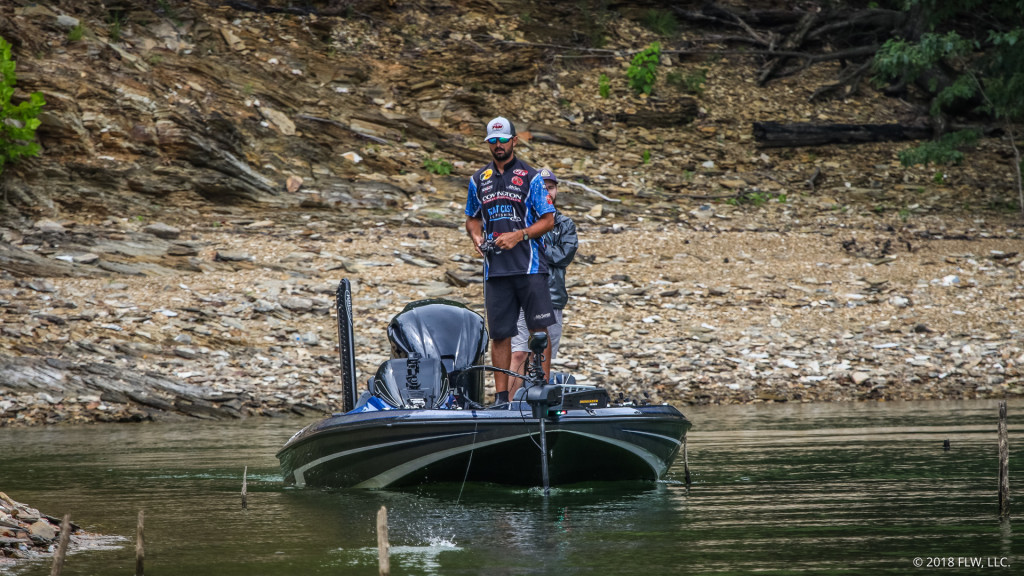
Like the Yamamoto Senko, the River2Sea Whopper Plopper has become synonymous with every competing bait in its class. Whether it’s a Berkley Choppo or any number of other newcomers to the Plopper-style bait market, “Whopper Plopper” is to fishing what “Kleenex” is to tissues.
That’s not to say other Plopper-style prop baits aren’t good. In fact, some FLW Tour pros will swear by the Choppo just as others will swear by the original Whopper Plopper. But for the purposes of this article, we’re going to break down how Tour pro Nick LeBrun employs the bait that changed the game and took the bass fishing world by storm in earnest less than half a decade ago – the River2Sea Whopper Plopper.
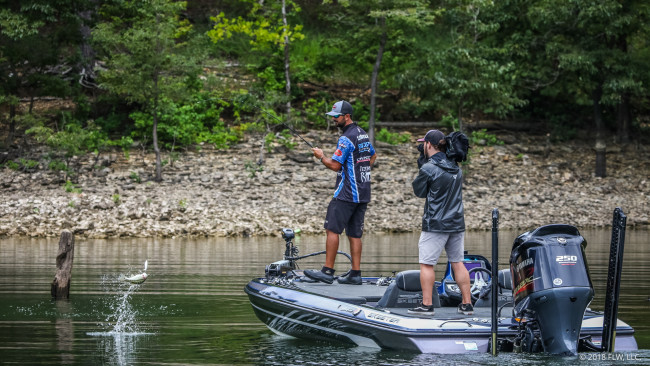
LeBrun’s history with the Whopper Plopper
As any tournament professional will tell you, it’s nearly impossible to master any one bait or technique. LeBrun is no exception; he’s still figuring it out as he goes. But the Whopper Plopper is one of the handful of baits he has a lot of confidence in, especially in the Mid-South on Ozark-style lakes.
“For me, I’m slowly but surely starting to get faith [in the Whopper Plopper] in other parts of the country, but from Hot Springs up to the Ozarks, that’s kind of my go-to,” he says. “When I’m up there in those Ozark-style lakes, it’s one of the first things that pops into my head.”
The Louisiana pro doesn’t typically throw Ploppers in the southernmost lakes he fishes – particularly Toledo Bend and Sam Rayburn – but he admits that’s mostly because he hasn’t had that one big day on those lakes with a Plopper in hand to convince him to throw it more often.
It’s about confidence, which is also the reason LeBrun typically favors a Plopper over the bait many pros might choose to use in its place – a buzzbait.
“The buzzbait is just a confidence thing,” LeBrun explains. “I know some guys that throw a buzzbait religiously and not so much a Plopper. I own a few buzzbaits, but that’s just not something I have a lot of faith in. I’ve caught some big fish on it, but probably the reason I don’t have faith in it is because I don’t ever throw it.”
So, while a good portion of the 2019 FLW Cup field was throwing buzzbaits around docks on Lake Hamilton, LeBrun was opting for a 110-size Whopper Plopper in just a couple basic colors. It’s what worked for him during practice, and while he ultimately went down swinging with a Plopper in hand (finishing in 24th place), the Plopper has generally been good to him in Arkansas. He boated 15 pounds on day one of the 2019 FLW Cup, and his fourth-place finish on Lake Ouachita in the 2018 Cup was bolstered in a big way by a 6-pounder he caught on a white Whopper Plopper.
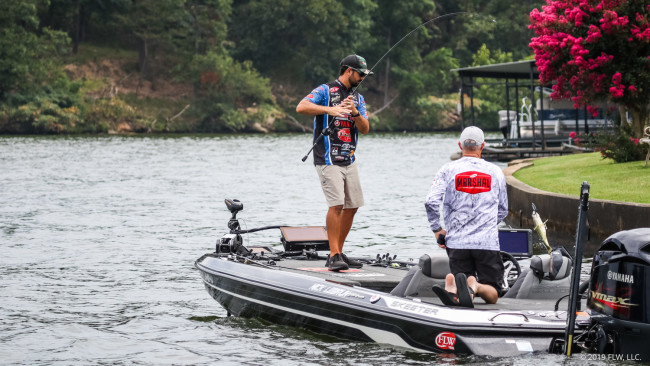
Selecting the right model
For LeBrun, throwing a Whopper Plopper is a pretty simple affair.
“I throw black and white, which, to be detailed, it’s the loon color or white pearl,” he explains. “A lot of people throw the bone color, and that’s why I don’t throw the bone. I like throwing the white, especially after catching a 6-pounder on it in the Cup last year. That was a confidence-builder for me.
“I keep it simple. I throw the white or the black, and, really, I find myself throwing the black most of the time. I don’t have some special formula of ‘well, when the pond straw is light brown and the squirrels are running on the left side of the tree, that’s when you throw the black.’”
LeBrun chooses his Ploppers based on the basic principles of topwater fishing: black for low-light conditions and white for sunny days. Of course, that’s not a hard-and-fast rule, and oftentimes LeBrun simply chooses a trial-and-error approach.
“I just kind of rig one up and throw it, and if I’m not getting bit, I might throw the other one for a couple hours,” he says. “I think colors catch more fishermen than they catch fish.”
That’s why LeBrun keeps his color selection simple. He finds that size and setup are much more important, especially in certain situations.
As a general rule, the rookie Tour pro will usually opt for the 130-size Plopper (a 130mm bait) to maximize his chances of catching quality fish, as opposed to fishing for a lot of smaller fish. To him, the Plopper is an all-or-nothing lure.
“It’s a zero-or-hero type deal,” he says. “I don’t think I’ve ever weighed in 12 pounds on a Plopper. If I did, it was two or three fish. I think that’s why some people don’t throw it. They hear about it and watch the videos and see the tournament results, and they go and tie one on and they fish it for 10 minutes without a bite and put it down and try something else.”
Still, there are times LeBrun really prefers the 110 size, like at Lake Hamilton during the 2019 Cup.
“For bass fishermen, you have the 90, the 110 and the 130,” LeBrun adds. “I say my go-to is the 130, even though the past two Cups I fished the 110, but that’s because I felt like the size of the fish were just smaller. You can catch a 12-inch fish on the 130.
“You can’t discount the 130. It will catch smaller fish. But, a tournament like Hamilton where a 12-incher really matters, I just wanted to have a smaller-profile bait to get that fish in my hands.”
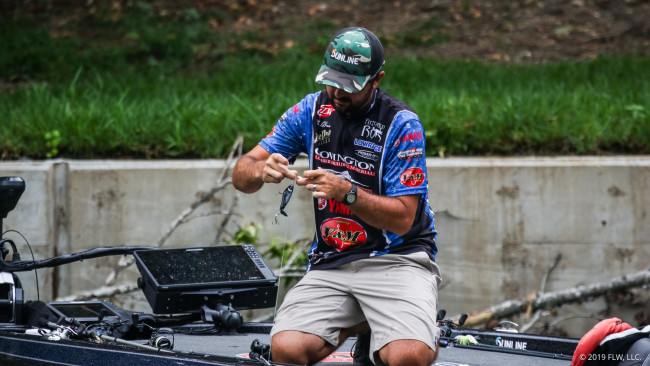
The setup
LeBrun keeps things simple with his setup, too, at least to a degree. He always makes one specific tweak to his Plopper out of the package, though.
“I take the factory hooks off, and I replace them with size 2 Hayabusa treble hooks,” he explains. “Two reasons I do that: It’s a little bit lighter-wire hook compared to what comes on it. I just think the hooks that they put on there are a little bit overkill. Also, the Hayabusa trebles come with an NRB coating that makes the hook kind of slick, and in my mind, it helps me get a few more fish in the boat.”
Apart from that, it’s basically straight from the package and onto his line. LeBrun likes 30- and 50-pound-test Sunline Xplasma Asegai (with no leader) for his Ploppers, and he’ll bounce around between the two line sizes based on what he’s targeting.
“I throw 50 the most, except for when the fish are smaller and I’m having to really get creative with my casts,” LeBrun says. “Like at Hamilton, I was having to pitch that bait and get it up under the walkways, and the fish were smaller – under 3 pounds, most of them. The lighter [30-pound] braid helps you manage that bait a little better, and also gets you some more distance.”
Distance can be important when fishing a bare bank or open water, when a long cast is more efficient, but when LeBrun is on a lake like Lake of the Ozarks, when “those 4- and 6-pounders are chomping,” it’s always 50-pound test.
“If all I’m having to do is throw it over the cables and reel it at that 45-degree angle, I’m going to go with 50, just for peace of mind and more control when messing with those cables,” he adds.
LeBrun has sometimes toyed around with the idea of using monofilament line instead of braid – most recently at the Cup on Hamilton, where the fish were smaller and he worried about “overpowering” them with heavy braid – but he ultimately chose not to for fear of losing a giant.
He’s able to get away with the limited-stretch braid choice because of the rod he employs for his Plopper setup – a 7-foot, 2-inch, medium-heavy Fitzgerald Bryan Thrift frog rod.
“That’s really the only rod I’ve tried on the Plopper,” he explains. “It’s done me a good job. I like it because it has enough tip to play the fish and not overpower it, but it has enough backbone to where, if you get a 6-pounder on, you’re going to be in control and you can boat-flip it if you want to.”
He pairs his Fitzgerald rod with a Fitzgerald Stunner reel in a 7:1 gear ratio to minimize the fatigue associated with winding a Plopper all day, and also to maximize his efficiency when covering a lot of water.
It’s all about the situation
Like all baits, there’s a proper time and place to throw a Plopper-style bait. During warmer months when big fish feeding up in the shallows are ultra-aggressive, a Plopper can put a ton of quality fish in the box. But LeBrun only reaches for a Plopper in the right conditions, even during the summer, and almost always on one particular type of lake.
“It goes back to the Ozark lakes,” he says. “My confidence is Grand, Hamilton, Ouachita, [Lake of the] Ozarks. Aside from Ouachita, all those lakes are filled with docks.”
It’s not necessarily that LeBrun only targets docks with Ploppers, or that any lake with a lot of docks is going to be prime fodder for a Plopper. It’s just that the lakes on which he’s had the most success with a Plopper happen to be Ozark lakes, which inherently have a lot of docks on them.
LeBrun also points out that, even on those lakes with docks, he’s caught a lot of good fish on bare banks with nothing but rock or pea gravel. This, he says, might have more to do with the types of baitfish and how they act on those fisheries.
“With walking baits, I throw it around bream beds and shad spawn situations,” says LeBrun. “Those are two scenarios where I’ve seen a stationary-type bait does better.”
However, when big gizzard shad are cruising around up on the bank, LeBrun figures the bass are doing the same thing. Throwing the Plopper is about matching the hatch – not necessarily from a size and profile perspective, but based on the idea that if shallow baitfish are moving around, so are the bass that are chasing them, and the bass will key on a lure that’s moving around, too. It doesn’t hurt that in those scenarios, a Plopper allows anglers to cover a lot of water.
“A lot of times, if I have the bass target-oriented, I like catching them on a stationary topwater like the Bill Lewis StutterStep, but sometimes a Plopper-style bait helps you cover more water,” LeBrun admits.
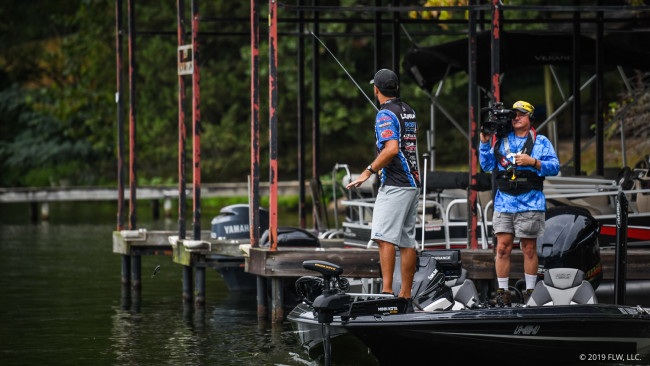
Picking apart docks
LeBrun is a master of putting treble-hooked baits where a lot of other anglers can’t. That includes the Plopper, and he’s not shy about pitching, casting and flipping one around any dock that might hold fish.
“When you’re approaching new water, you kind of have to fish it all,” he says. “Down the face of the dock first, then the sides and then behind. It takes some covering water to get dialed in.”
In other words, use trial and error until you’re able to establish a pattern. LeBrun says he’s caught fish on a Plopper around pretty much every kind of dock (whether stationary or floating) and every part of those docks (from pilings to cables to walkways).
He has a particular penchant for fishing behind them, which, by extension, means fishing under a lot of walkways.
“Different tournaments and different lakes I would throw back behind the dock and around the walkway and then kick it on high and go around the face of the dock,” he explains. “The fish were only behind the docks.
“I have a lot of confidence fishing behind the dock. It’s hard to throw a Plopper under a walkway out the other side. It would be so much easier to do that with a frog or even a buzzbait or a spook. You take that Plopper and put some heat on it, and if you are a few inches off, you might tear it up if your cast isn’t right on. I like it, though. It’s uncoventional. People don’t think of a treble-hooked bait to pitch into tight places, but it will pay off.”
There’s certainly less mystery to the where and when of catching fish on a Plopper when you have a lot of experience using one.
“Anybody who throws the Plopper a lot, especially around these docks, you kind of know where you’re going to get bit,” LeBrun says.
Part of it is experience, and part of it is choosing the right bait at the right time. LeBrun has proved time and again that he’s awfully good at that part.
And if LeBrun is throwing a Whopper Plopper, it’s because he knows it’s a bait that will catch a lot of quality fish.
“I’ve got eight or 10 baits I throw all over the country, and that’s about it,” he says. “I’ve always had to commit time to it.
“The biggest message I have to the user is that you have to commit to it; it’s kind of like flipping grass. It’s a deal where you can’t just go do it for an hour. You have to really put in some time and some hours with it.”
Coming from someone who has certainly put the time in to figure out the Whopper Plopper’s secrets, that’s advice you can take to the bank.
